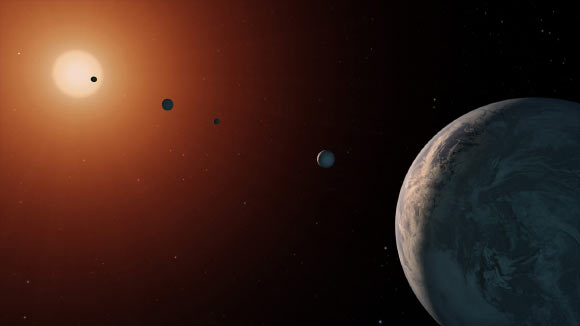A research team says the TRAPPIST-1 planetary system — a compact system of at least seven exoplanets with sizes similar to Earth — formed between 5.4 and 9.8 billion years ago. This is up to twice as old as our own Solar System.

This illustration shows what the TRAPPIST-1 planetary system might look like from a vantage point near TRAPPIST-1f (at right). Image credit: NASA / JPL-Caltech.
TRAPPIST-1 is an ultracool dwarf star in the constellation Aquarius, 38.8 light-years away.
The star is barely larger than Jupiter and has just 8% of our Sun’s mass. It is rapidly spinning and generates energetic flares of UV radiation.
TRAPPIST-1 is host to seven transiting planets, named TRAPPIST-1b, c, d, e, f, g and h.
All these planets are similar in size to Earth and Venus, or slightly smaller, and have very short orbital periods: 1.51, 2.42, 4.04, 6.06, 9.21, 12.35 and 20 days, respectively.
They are likely all tidally locked, meaning the same face of the planet is always pointed at the star, as the same side of the Moon is always pointed at Earth. This creates a perpetual night side and perpetual day side on each TRAPPIST-1 planet.
TRAPPIST-1e, f and g lay in the star’s habitable zone, meaning they may harbor suitable conditions for life.
At the time of its discovery, astronomers believed the TRAPPIST-1 system had to be at least 500 million years old, since it takes stars of the host star’s low mass roughly that long to contract to its minimum size, just a bit larger than the planet Jupiter.
However, even this lower age limit was uncertain; in theory, the star could be almost as old as the Universe itself.
“Our results really help constrain the evolution of the TRAPPIST-1 system, because the system has to have persisted for billions of years,” said Professor Adam Burgasser, an astronomer at the University of California, San Diego.
“This means the planets had to evolve together, otherwise the system would have fallen apart long ago.”
Some of the clues Professor Burgasser and his colleague, Dr. Eric Mamajek of NASA’s Jet Propulsion Laboratory, used to measure the age of the system included how fast the parent star is moving in its orbit around the center of the Milky Way (speedier stars tend to be older), its atmosphere’s chemical composition, and how many flares TRAPPIST-1 had during observational periods.
These variables all pointed to a star that is substantially older than our Sun.
“We collate empirical age constraints based on the color-absolute magnitude diagram, average density, lithium absorption, surface gravity features, metallicity, kinematics, rotation, and magnetic activity; and conclude that TRAPPIST-1 is a transitional thin/thick disk star with an age of 7.6±2.2 billion years,” the researchers explained.
Low-mass stars like TRAPPIST-1 have temperatures and brightnesses that remain relatively constant over trillions of years, punctuated by occasional magnetic flaring events.
The lifetimes of such stars are predicted to be much, much longer than the 13.7 billion-year age of the Universe (the Sun, by comparison, has an expected lifetime of about 10 billion years).
“Stars much more massive than the Sun consume their fuel quickly, brightening over millions of years and exploding as supernovae,” Dr. Mamajek said.
“But TRAPPIST-1 is like a slow-burning candle that will shine for about 900 times longer than the current age of the Universe.”
It is unclear what this older age means for the habitability of TRAPPIST-1 planets.
On the one hand, older stars flare less than younger stars, and the researchers confirmed that TRAPPIST-1 is relatively quiet compared to other ultracool dwarf stars.
On the other hand, since the planets are so close to the star, they have soaked up billions of years of high-energy radiation, which could have boiled off atmospheres and large amounts of water.
In fact, the equivalent of an Earth ocean may have evaporated from each TRAPPIST-1 planet except for the two most distant from the host star: planets g and h.
In the Solar System, Mars is an example of a planet that likely had liquid water on its surface in the past, but lost most of its water and atmosphere to the Sun’s high-energy radiation over billions of years.
However, old age does not necessarily mean that a planet’s atmosphere has been eroded.
Given that the TRAPPIST-1 planets have lower densities than Earth, it is possible that large reservoirs of volatile molecules such as water could produce thick atmospheres that would shield the planetary surfaces from harmful radiation.
A thick atmosphere could also help redistribute heat to the dark sides of these tidally locked planets, increasing habitable real estate. But this could also backfire in a ‘runaway greenhouse’ process, in which the atmosphere becomes so thick the planet surface overheats – as on Venus.
“If there is life on these planets, I would speculate that it has to be hardy life, because it has to be able to survive some potentially dire scenarios for billions of years,” Professor Burgasser said.
The findings will be published in the Astrophysical Journal (arXiv.org preprint).
_____
Adam J. Burgasser & Eric E. Mamajek. 2017. On the Age of the TRAPPIST-1 System. ApJ, submitted for publication; arXiv: 1706.02018
This article is based on text provided by the National Aeronautics and Space Administration.







